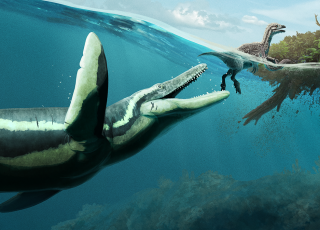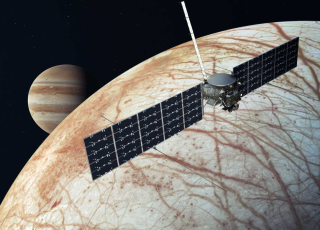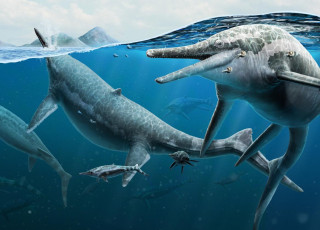Waters in the West: The Great Salt Lake
By Jude Coleman

Bonnie Baxter, Ph.D., on the shore of the Great Salt Lake.
The Great Salt Lake is saltier than the ocean, but it hasn't been connected to the sea for millions of years. It’s the remnants of an even larger lake that began drying out around 13,000 years ago. But today, the lake is in peril. To understand how things like climate change and water use are affecting the lake, biologist Bonnie Baxter researches how microorganisms deal with increasing salinity. The Westminster University professor also founded—and is currently director of—the Great Salt Lake Institute. The group collaborates with researchers and students around the world to study the lake.
Baxter is part of NHMU’s upcoming 2025 Lecture Series Waters of the West expert panel happening April 17 at the Salt Lake City Library. The Museum spoke with her about the biology of the lake, and how it might change in the future.
This interview has been edited for length and clarity.
What organisms live in, and rely on, Great Salt Lake?
The lake itself is bisected into two parts. The north part of the lake is cut off from the fresh water that flows in from the mountain range, so that north part got saltier and saltier. In the summer it gets up to 34 percent salt; the ocean is 3.4 percent. So that part is like a microbial soup. There's bacteria, archaea, fungi, and algae, and that's about it. There are these bright pink microbes that live there, they grow in hyper saline systems all around the world.
The south arm is a vibrant ecosystem. It’s right now at about 13% salt. And what happens when you increase the salt of an ecosystem is that you limit biodiversity. The only animals that live in the south arm water are the brine shrimp and the brine flies, and they have to eat a bunch of microorganisms in order to survive. The microorganisms are more complex in the south arm—there's a lot more algae, there's cyanobacteria...some fungi and bacteria that help form mats on the bottom of the lake. And then we have 10 million birds that come to eat those two invertebrates (brine flies and shrimp). So, the whole ecosystem sort of stands on the backs of these microorganisms that collect energy from the sun and hold it in the system so that the invertebrates can survive.
I think my favorite organism would be the haloarchaea. “Halo” is the Greek root for salt, and “archaea” means ancient. So, they are the “ancient salty ones.” They're small, like bacteria, and they have these robust pink colors. They're really beautiful to grow in the lab.
Why is the lake under threat?
Desiccation—drying out—is one threat. The second threat is, as the lake shrinks, it concentrates the salt, and the salt water can become too salty for the life that lives in it.
Imagine a cereal bowl at the bottom of a basin: If you use all the water upstream, none of it trickles down to the little bowl. Great Salt Lake is the bowl at the bottom. Between shifts in precipitation, so less snow than rain, for example, which is one of the hallmarks of climate change; increased temperatures in the summer, which causes more evaporation; and overuse of water, all of those things can contribute to conditions that mean less water makes it to Great Salt Lake.
How will that impact the creatures living in the lake?
On the bottom of the lake are microbial mats. When photosynthesis happens, it causes minerals to precipitate out of the water, and so these microbes actually make a rock. If you were to go to the south arm of the lake, you would see these tire-sized mounds that are covered with green mats. And they're really important, particularly for the brine flies, because that's where the larvae hang out and where their little cocoons develop. Since they're in the shallow parts of the lake, as the lake shrinks, they're becoming exposed. Those mats are both food and habitat for the brine flies.
In 2022, things got so salty here at Great Salt Lake that the brine flies were smaller in all their life stages...and we stopped seeing adults entirely that year. So we know that the high salt can impact the microbes at the bottom of the food chain, and that they can impact both the shrimp and the flies. If the flies aren't here, we're going to lose the birds that depend on the flies.
The birds also get salt stressed. Water birds have a little salt gland in the back of their nostrils that helps absorb all the extra salt. And that gland can get overwhelmed. As they're eating brine shrimp out of the water, they're taking in salt water, and they're toxifying their organs. So, at each level of the food chain, you have an impact on growth and an impact on food
Are there any other ripple effects from the changes to Great Salt Lake?
The microbial mats make a biofilm that holds down the sediment. As the water level decreases, the exposed playa will create dust. The microbes may play a roll, because they really are something covers the bottom and prevents dust. I think that could be a bigger deal than we know.
Is there anything you wish more Utahans knew about Great Salt Lake biology?
I like to think of the organisms there as both fragile and resilient. When people visit the Pacific Northwest, they go to tide pools and see creatures that can survive being dried out for a couple of hours before the tide shifts again. I think Great Salt Lake is like that on an annual scale. We're doing experiments in my lab trying to regrow the mats that are dried out, for example. The life in the lake is fragile in that you can only push it so far, but the resilience is kind of heartwarming. I'm hoping, if we can change how we behave with water, and we can get more water to the lake, that we can restore the ecosystem.
Waters in the West
Hear from Bonnie Baxter among other experts during the 2025 Lecture Series Waters in the West panel hosted at the Salt Lake City Library on April 17 at 7 p.m. The event is free to attend with RSVP.



